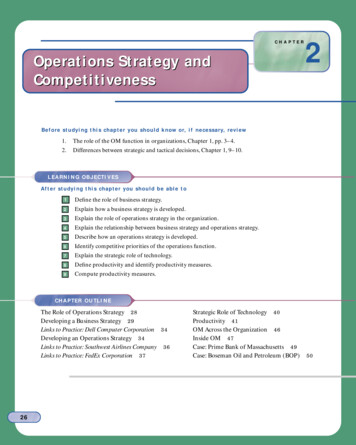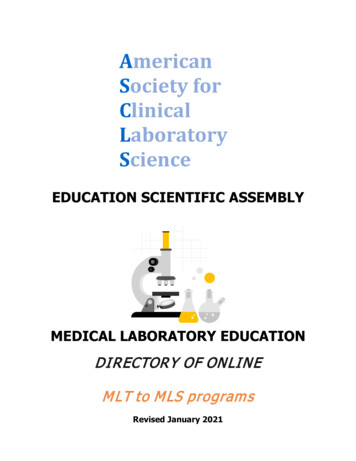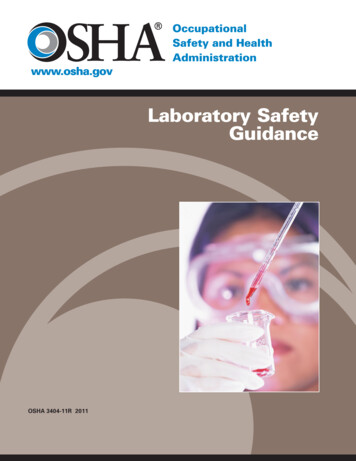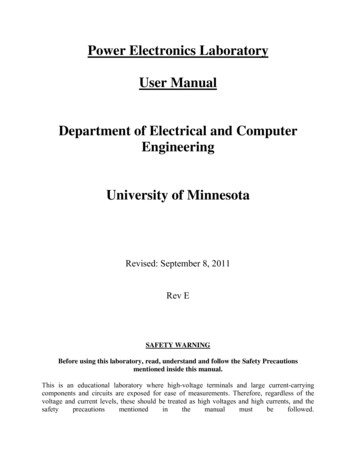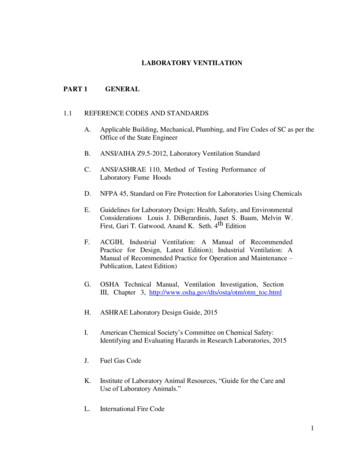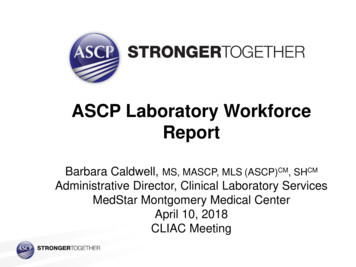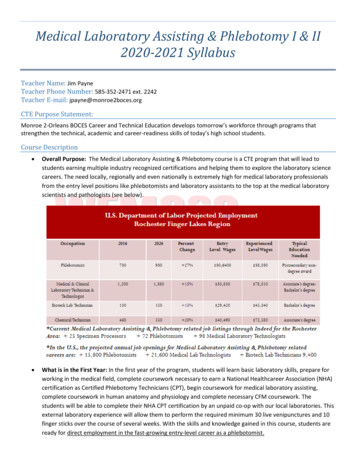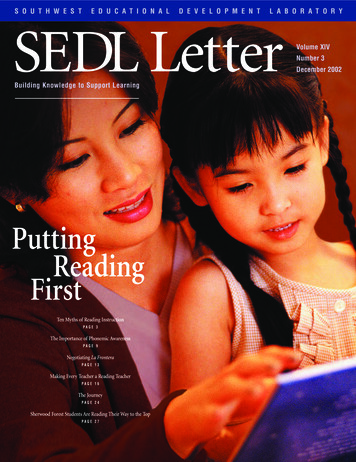
Transcription
S O U T H W E S TE D U C A T I O N A LD E V E L O P M E N TL A B O R A T O R YSEDL LetterBuilding Knowledge to Support LearningPuttingReadingFirstTen Myths of Reading InstructionPAGE 3The Importance of Phonemic AwarenessPAGE 9Negotiating La FronteraPAGE 13Making Every Teacher a Reading TeacherPAGE 16The JourneyPAGE 24Sherwood Forest Students Are Reading Their Way to the TopPAGE 27Volume XIVNumber 3December 2002
SEDL LetterThe Award-WinningMagazine of theSouthwest EducationalDevelopment LaboratoryPutting Reading FirstISSN/520-7315Wesley A. Hoover, Ph.D.President and CEOJoyce S. Pollard, Ed.D.Director, Office ofInstitutionalCommunicationsLeslie Asher Blair, M.A.EditorCREDITSJane Thurmond (Austin,Texas) designed SEDL Letter.The photographs on pages20–21 and 27–31 were takenby SEDL staff. The coverphotograph and those onpages 3 and 32 are GettyImages. The photographs onpages 2, 5, 9, 12, 13, 14, 17,and 26 are royalty-free images Eyewire, Image 100, orPhotoDisc. Nancy Richey(Austin, Texas) wascopyeditor for this issue.SEDL Letter complements anddraws upon work performedby the Southwest EducationalDevelopment Laboratory undera variety of funding sources,including the U.S. Departmentof Education and the U.S.Government. The publicationis not supported with directprogram funds related to anySEDL programs or projects.SEDLetter does not necessarilyreflect the views of the U.S.Government or any othersource. You are welcometo reproduce SEDLetter anddistribute copies at no cost torecipients; please credit theSouthwest EducationalDevelopment Laboratory aspublisher and respect thecopyrights of designatedillustrators, designers, andcontributors. SEDL is anEqual Opportunity/AffirmativeAction Employer and iscommitted to affording equalemployment opportunitiesfor all individuals in allemployment matters.Available in alternative formats.By Leslie Blair, EditorImagine my surprise when halfway through my son’s kindergarten school year, his teacher stoppedme one day and asked “How about our little reader?” It seems he had learned to read early and withoutmy even knowing it. He is one of the lucky students who started school with strong pre-literacy skills andan excellent kindergarten teacher. And his kindergarten class was fairly small as public schools go, withonly 12 students in the class.As we know, not all students are so lucky. Some come to school without knowing the alphabet orunderstanding the concept of print. Others must learn to read in a language that is not their nativelanguage. Some are put in crowded classrooms and still others have teachers who haven’t receivedadequate training in reading instruction. With passage of the No Child Left Behind Act and its ReadingFirst component, there is the expectation that we can help all of these students learn to read early andwell. It will be a challenge, however, as states, districts, and schools scramble to meet the tougher newrequirements as well as identify research-based programs and practices.In this issue of SEDL Letter we touch on some of the issues related to Reading First. “Ten Mythsof Reading Instruction” is a rundown of some fallacies around reading instruction. “The Importanceof Phonemic Awareness” addresses one of Reading First’s five essential components of effective readinginstruction. We also look at how to help struggling secondary readers in “Making Every Teacher aReading Teacher: Putnam City Secondary Educators Work to Help Struggling Readers” andhow to meet the needs of migrant students in “Negotiating La Frontera: Reading and theMigrant Student.” New Orleans teacher Kathleen Theodore offers hopewith her essay, “The Journey,” about how she struggled to teachbeginning readers as a novice teacher. In our final piece, “SherwoodForest Students Are Reading Their Way to the Top,” we visit aNew Orleans school where everyone puts reading first.The December issue marks the first time we haveincluded a few activities for teachers to use in theclassroom (see pages 28–31). Results from our surveylast year indicated that teachers wanted the magazine toinclude instructional materials, so we hope these mightbe useful to some of our readers. Also, this issue of SEDL’smagazine is the first with our name changed from SEDLetterto SEDL Letter. And it is fitting that the change coincideswith our issue’s theme of “Putting Reading First.” Althoughthe magazine has been called SEDLetter for about 15 years,we decided it was a difficult title to read.As always, we love to hear from our readers about what theyliked or didn’t like in the magazine. Please let us know whatyou think about articles in this issue or send suggestionsfor future issues by emailing me at lblair@sedl.org.Happy Holidays from all of us at SEDL!
December 2002 3Ten Myths ofReading InstructionBy Sebastian WrenMyth #1Learning to read is a naturalprocess.If readingwere natural,everybodywould bedoing it, andwe wouldnot have toworry aboutdealing with a‘literacy gap.’It has long been argued that learning to read, likelearning to understand spoken language, is a naturalphenomenon. It has often been suggested thatchildren will learn to read if they are simply immersedin a literacy-rich environment and allowed to developliteracy skills in their own way. This pernicious beliefthat learning to read is a natural process resultingfrom rich text experiences is surprisingly prevalent ineducation — despite the fact that learning to read isnot only unnatural, it is one of the most unnaturalthings humans do.There is a difference between learning to readtext and learning to understand a spoken language.Learning to understand speech is indeed a naturalprocess; starting before birth, children tune in tospoken language in their environment, and as soonas they are able, they begin to incorporate a language.If the linguistic environment is not sufficiently richor if it is confusing, the innate drive to find a languageis so strong that, if necessary, children will createa language of their own (examples of this includetwin languages and pidgin languages). Given theopportunity, children will naturally develop all ofthe essential comprehension skills for the languageto which they are exposed with little structured orformal guidance.By contrast, reading acquisition is not natural.While the ability to understand speech evolved overmany, many thousands of years, reading and writingare human inventions that have been around formerely a few thousand years. It has been only withinthe past few generations that some cultures havemade any serious attempt to make literacy universalamong their citizens.If reading were natural, everybody would bedoing it, and we would not have to worry aboutdealing with a “literacy gap.” According to the NationalInstitute for Literacy and the Center for EducationStatistics, more than 40 million adults in this countryalone are functionally illiterate, and despite our besteducational efforts, approximately 40 percent of ourfourth graders lack even the most basic reading skills.These staggering numbers provide evidence that readingis a skill that is quite unnatural and difficult to learn.Myth #2Children will eventually learn toread if given enough time.This is arguably the second most pernicious myth,and it is closely related to the first. Many who claimthat reading is natural also claim that children shouldbe given time to develop reading skills at their ownpace. This is a double-edged sword because, while itis true that children should be taught to read indevelopmentally appropriate ways, we should notsimply wait for children to develop reading skillsin their own time. When a child is not developingreading skills along with his or her peers, thatsituation should be of great concern.Over time, the gap between children who havewell-developed literacy skills and those who do notgets wider and wider. In the early grades, the literacygap is relatively easy to cross, and with diagnostic,focused instruction, effective teachers can helpchildren who have poor literacy skills becomechildren with rich literacy skills. However, if literacyinstruction needs are not met early, then the gapwidens — the rich get richer, and the poor getpoorer — until it gets so wide that bridgingit requires extensive, intensive, expensive, andfrustrating remedial instruction. The gap reaches
December 2002 4this nearly insurmountable point very early. Researchhas shown that if a child is not reading gradeappropriate materials by the time he or she is in thefourth grade, the odds of that child ever developinggood reading skills are slim. It is still possible, but it ismuch more difficult, and the child’s own motivationbecomes the biggest obstacle to success.Myth #3There are a fewprograms that,if properlyimplemented,could help aschool movein the rightdirection, butnothing couldever takethe place of aknowledgeableand talentedteacher.Reading programs are‘successful.’It is common for schools to buy an off-the-shelfreading program to address their reading instructionneeds and trust that the program will solve theirschool’s literacy issues. Typically, these programsare designed to address a single part of theoverall reading curriculum (for example, phonicsprograms or phoneme awareness programs orreading motivation programs), but often a schoolpurchases a program with the hope that it will bea cure for the school’s low reading achievement.Although such reading programs can be a usefulpart of a larger reading curriculum, no readingprogram by itself has ever been shown to be truly“successful”— not with all children and all teachers.And no reading program by itself has been shownto accelerate all children to advanced levels ofperformance. Some of these programs, whenproperly implemented, have been shown to improveoverall reading scores significantly (especially inlow-performing schools), but that improvement isoften a long way from what anyone should describeas “success.” If 60 percent of the students in a schoolare performing unacceptably on the benchmarkreading assessments, moving that number to40 percent is an improvement, but it is stillunsatisfactory. There are a few programs that,if properly implemented, could help a school movein the right direction, but nothing could ever takethe place of a knowledgeable and talented teacher.Typically these programs do not provide substantialprofessional development for teachers beyond thebasic training teachers need to implement theprogram in their classrooms.Research has repeatedly indicated that the singlemost important variable in any reading program isthe knowledge and skill of the teacher implementingthe program, so why do we persist in trying todevelop “teacher-proof” programs? Some wouldargue that it is our overdependence on suchprograms that prevents us from cultivating moreknowledgeable and effective teachers. To achievesuccess for all children, teachers must becomeextremely sophisticated and diagnostic in theirapproach to reading instruction, and substantialresources must be devoted toward professionaldevelopment for teachers. Every child is different:A program cannot be sensitive to the varied andrapidly evolving learning needs of individualchildren, but a knowledgeable teacher certainly can.Myth #4We used to do a better job ofteaching children to read.The good old days weren’t always so good. We have,in fact, never done a better job of teaching children toread than we do today. The bad news is, we’ve neverreally done a worse job either. We are basically justas successful today as we have always been — notvery successful.Nothing illustrates this better than the NationalAssessment of Educational Progress (NAEP). Thisassessment has been given to children across thecountry aged 9, 13, and 17 since 1970. Studentperformance at those three age levels has not changedsubstantially in over 30 years — consistently between24 percent and 39 percent of students have scoredin the “below basic” category (depending on the agetested), and between 3 percent and 7 percent havescored in the “advanced” category. Other investigationshave found that literacy rates have not really changedin this country since World War II.While the literacy rates have not changedsubstantially, the demand and need for literacy hasincreased markedly. Literacy now is a prerequisitefor success. In the future, the ability to read will bean increasingly indispensable skill given the growingtechnology and information explosion.Clearly we do not need to get back to the old waysof teaching children to read — the old ways were reallyno better than (and some would argue, no differentfrom) the current ways. Relatively recent research hasgiven us great insights into why some children havedifficulty learning to read, and the next frontier inreading education is to help teachers understandand apply that research information.Myth #5Skilled reading involves usingsyntactic and semantic cues toguess words, and good readersmake many ‘mistakes’ as theyread authentic text.Research indicates that both of these claims are quitewrong, but both are surprisingly pervasive in readinginstruction. The idea that good readers use contextualcues to guess words in running text comes from amethod of assessment developed by Ken Goodmanthat he called “miscue analysis.” For his dissertation,
December 2002 5Goodman examined the types of mistakes that youngreaders make and drew inferences about the strategiesthey employ as they read. He noticed that the children in his studies very often made errors as theyread, but many of these errors did not change themeaning of the text (like misreading “rabbit” as“bunny”). He surmised the reason must be that goodreaders depend on context to predict upcomingwords in passages of text. He further suggestedthat for good readers, these contextual cues are soimportant that the reader needs only to occasionally“sample” from the text — that is, look at a few ofthe words on the page — to confirm the predictions.Children who struggle to sound out words, Goodmansays, are overdepending on letter and word cues andshould learn to pay more attention to the semanticand syntactic cues.Goodman’s model, which eventually gave riseto the “Three Cueing Systems” model of wordrecognition, is extremely influential in readinginstruction, but has never been supported byresearch evidence.In fact, repeated studies have shown that onlypoor readers depend upon context to try to “guess”words in text— good readers depend heavily uponthe visual information contained in the wordsthemselves (that is, the letter and word cues)to quickly and automatically identify the word.Psychologist and researcher Keith Stanovich hasbeen especially critical of the three-cueing-systemsmodel because the predictions made by the modelare exactly the opposite of what has been observedin research studies. Philip Gough, a psychologyprofessor at The University of Texas at Austin, and Iaddressed the second claim and showed that goodreaders almost never make any mistakes at all whenthey read, which means the notion of conductinga “miscue analysis” is somewhat suspect — howcan you perform a miscue analysis when thereare typically no miscues? We had over 400 collegestudents read a passage of text from Ken Goodman’sPhonics Phacts (Heinemann, 1993) and showedthat the modal number of mistakes made bythese students was zero. Almost all of the studentsread the passage flawlessly. To suggest that goodreaders correctly guess the words in the passagewith 100 percent accuracy stretched theboundaries of credulity.However, to be sure, weexamined how accuratereaders would be ifthey were forced to usesemantics and context astheir only cues. We concealedthe passage of text and askedour college students to guesseach of the words in the passageone at a time; after each guess, thecorrect word was revealed, and students were askedto guess the next word. This process was repeatedfor every word in the passage, so the students alwaysknew the words leading up to the unknown word.We found that, given unlimited time to ponder,students were able to correctly guess one out often content words in the passage. That’s a 90 percentfailure rate, as opposed to the zero percent failurerate seen in skilled readers who were not forced tomake guesses based on context.Research has shown that good readers dependvery heavily upon the visual information containedin the word for word identification (what iscommonly called the graphemic information ororthographic information). The semantic andsyntactic information are critical for comprehensionof passages of text, but they do not play an importantrole in decoding or identifying words. Good readersmake virtually no mistakes as they read becausethey have developed extremely effective and efficientword identification skills that do not depend uponsemantics, context, or syntax. For good readers, wordidentification is fast, fluent, and automatic — it mustbe so that their attention can be fully focused onusing semantics and syntax to comprehend the text.Myth #6Research can be used to supportyour beliefs, whatever they are.Unfortunately, it is true that many people selectivelysearch and sample the research literature, citingonly the research that seems to support theirpreconceived notions. Often research resultsare skewed or biased to appear to beconsistent with hypotheses proposed.And unfortunately, there are many
December 2002 6It is true that‘researchbased’ fadsand programscome andgo, but thatstems frommisuse ofthe term‘researchbased’.people who are unwilling to reject a hypothesis or atheory even when research evidence does not supportthat theory. Adding to the problem of poor researchis the problem that the public is largely uninformedabout the hallmarks of good research.Many articles appear to be “research” articles,but are not. The article you are reading right now,for example, might be cited as “research” by some,but in fact this is not a research article. This is ratheran article written by a researcher, and that is animportant distinction. This article, and others thatappear in journals like Phi Delta Kappan and TheReading Teacher are written as informative articles.These articles are usually meant to be analogous tonewspaper articles, but are often more like editorialsor commentaries. They may stimulate thought andfocus attention on interesting issues, but they arenot in any way “research” articles.Publishing a research article requires a greatdeal of rigor and objectivity, and all good researchpublications have a formal, relatively unbiased expertpeer review process. Research studies are tested andscrutinized from many angles by multiple, unrelatedresearchers. There is documented objectivityassociated with research, and where possible, thereis replication of results. And even after all of that, ahealthy skepticism is still adopted by the researchcommunity. Researchers know that one piece ofresearch evidence is nothing to get excited about.Several bits of evidence might get some attention.But it is only when there is substantial convergentevidence from multiple sources supporting a theorythat the research community is willing to embracethe theory.It takes years to convince the research communitythat a theory has merit, but often it takes no time atall to convince the public. The media tend to payattention to unexpected or unusual findings —take the recent contretemps about cold fusion, forexample. There is a mountain of evidence showingthat cold fusion is not possible given our currenttechnology and understanding of physics. But whenone research team circumvented the normal channelsof peer review and claimed that they had found asolution for cold fusion, they were celebrated in themedia, and the public paid a great deal of attentionto their claims.It is true that “research-based” fads and programscome and go, but that stems from misuse of theterm “research based.” All of us need to adopt a bitof healthy skepticism, and we should demand that asubstantial research base be provided as evidence tosupport claims. We also must learn to pay moreattention to the research evidence and less attentionto the messenger — the credentials of a researcher areimportant, but even researchers can editorialize andput forth unfounded opinions. That a well-knownresearcher said it doesn’t make it so.Myth #7Phoneme awareness is aconsequence — not a cause —of reading acquisition.The evidence showing the importance of phonemeawareness to literacy acquisition is overwhelming.Still, there are some who are not convinced. Someclaim that teaching children to develop phonemeawareness is not necessary or even beneficial. Theyusually believe children develop phoneme awarenessas they learn to read, but they claim phoneme awareness is nothing more than a byproduct of readingacquisition, arising as a result of learning to read —not the other way around. Further, it is often arguedthat phoneme awareness instruction is “inauthentic”and unnatural and therefore inappropriate. Researchfindings do not support this view.First, it is clear that phoneme awareness is anecessary prerequisite for developing decoding skillsin an alphabetic writing system such as English.Phoneme awareness in the early grades is one ofthe best predictors of future reading success. Allsuccessful readers possess phoneme awareness.Those who do not have phoneme awareness arealways poor readers, and poor readers almost neverhave phoneme awareness. The most compellingevidence for the importance of phoneme awarenessstems from the research demonstrating that whenchildren are taught to develop phoneme awarenessthey are more likely to develop good word decodingskills — and they develop those skills faster andearlier than children who are not taught to be awareof phonemes in spoken words.Second, phoneme awareness instruction canbe authentic and natural. Teachers can use music,tongue twisters, poetry, and games to help childrendevelop phoneme awareness. Children enjoy playingthese games; they love to experiment with language,and teachers should give them every opportunity toexplore spoken language.Given the importance of finding developmentallyappropriate ways of helping children to developfoundational reading skills as early as possible (seeMyth #2), assessment of phoneme awareness shouldbegin early, and games and lessons that help childrendevelop an awareness of phonemes in speech shouldbe used to help those that need it.Myth #8Some people are justgenetically ‘dyslexic.’The belief in an underlying genetic cause for dyslexiaignores the fact that reading and writing simply havenot been around long enough to become a specificpart of our genetic makeup (see Myth #1). It was
December 2002 7Further Readinglong argued that when a disparity existed betweena person’s intelligence and their reading skill, theperson should be described as a “dyslexic.” Theterm “dyslexic” eventually became a catch-allterm used to account for people who failed to learnto read despite apparent intellectual capacity andenvironmental support.The term “dyslexia” has come to encompassso many reading difficulties that it is of little use.The term simply means “difficulty with words,” andanybody who has not learned to read could be called“dyslexic.” There is nothing about this definition thataddresses the underlying reasons for the difficultywith words. We know that people fail to learn to readfor a very wide variety of reasons, and categorizing allnonreaders under the “dyslexia” umbrella belies thecomplexity of reading disorders.Clearly, some people have more difficulty learningto read than others. In broad strokes, the threereasons people have difficulty developing basicreading skills are that they have difficulty developing1. decoding skills,2. language comprehension skills, or3. both decoding and language comprehension skills.Difficulties developing decoding skills very oftenarise from difficulties processing sounds in speech.Some people seem to have an easier time thanothers mentally breaking spoken words apart anddiscerning the subparts of spoken words — such asalliteration and rhyme. To learn to decode words inalphabetic systems like English, it is necessary tounderstand that the letters in text represent thephonemes in speech. It is unlikely that people whohave difficulty hearing and manipulating thephonemes in speech will make the connectionbetween letters and phonemes.It could be argued that there is a geneticfoundation for variations in phonological processingskills — some people seem to naturally tune in tospeech sounds, and others seem to have difficultyexamining and manipulating the phonemes inspeech. Furthermore, these abilities have a tendencyto run in families. However, even if there are specificgenetic foundations for phonological processingskills, we know that it is quite easy to teach childrento be aware of the phonemes in speech whatever theirgenetic tendencies.While some children have difficulty developingdecoding skills because of poor phonologicalprocessing skills, other children simply do not getadequate instruction in other necessary knowledgedomains important for developing good decodingskills (such as concepts about print, letter knowledge,and knowledge of the alphabetic principle). Orthey fail to get sufficient opportunities to practicedecoding real words and thus fail to develop fluent,automatic word recognition skills. There is no geneticfactor for insufficient instruction — the deficit is notintrinsic to the child; it is intrinsic to the classroomand the system that failed to help the child to developthese critical knowledge domains.Difficulty developing language comprehensionskills often stems from either insufficient exposure toor practice with a particular language (children oftenhave well-developed language comprehension skillsin languages other than English). To understand alanguage well, children must develop a rich vocabulary and appreciation for semantics, and they mustcombine that with a wealth of background knowledgeabout the world. They also need to have an implicitunderstanding of the mechanics of the language(syntax), and their ear needs to be tuned to thephonology of the language so they can distinguishwords that sound similar (like “hair” and “here”).There are very few genetic factors that lead toreading difficulty; most factors that result in readingdifficulty are environmental, but either way, researchhas shown that good instruction can overcome all ofthese factors. The unpleasant fact that we must cometo terms with is that the reason that so many childrenare “dyslexic” has little to do with the genetic makeupof the children; it has to do with the quality of theireducation. They were simply never taught to read.Myth #9Short-term tutoring for strugglingreaders can help them catch up withtheir peers, and the gains made willbe sustained.Many reading instruction interventions common inschools involve pulling a student out of the regularclassroom for a period of time and sending thatstudent to a reading specialist or a tutor for short,intensive, one-on-one instruction sessions. After afew weeks or months of intensive intervention, thestudents are exited from the intervention program,and they resume normal classroom activities. Theprevalence of these fairly expensive programs reflectsan underlying belief that this sort of intervention iseffective and that the gains children experience inthese programs are sustained when they return tothe normal classroom.But it is evident that such gains as are made bychildren in these programs are not sustained for verylong once they are exited from the program. Studiesof pull-out tutoring programs have shown thatchildren who are not thriving like their peers inthe classroom continue to fail to thrive when theyare placed back in that classroom full time. Thissuggests that there is something about the classroomenvironment that is not supporting and scaffoldingthese children as they learn to read.To learn more about theseand other related issuesin reading instruction andreading research, curiousreaders are encouragedto examine these titles:Adams, M. J. 1990.Beginning to read:Thinking and learningabout print. Cambridge,MA: MIT Press.Adams, M. J. 1998.The three-cueing systems.In J. Osborn and F. Lehr(eds.), Literacy for all:Issues in teaching andlearning, 73–99. New York:Guilford Press.Gough, P. B., and S. A.Wren. 1999. Constructingmeaning: The role ofdecoding. In ReadingDevelopment and theTeaching of Reading, eds.J. Oakhill and R. Beard,59–78. Malden, MA:Blackwell.Moats, L. C. 1999. Teachingreading is rocket science.Washington D.C.: AmericanFederation of Teachers.Snow, C. E., W. S. Barnes,J. Chandler, I. F. Goodman,and L. Hemphill. 1991.Unfulfilled Expectations:Home and SchoolInfluences on Literacy.Cambridge: HarvardUniversity Press.Snow, C., S. Burns, andP. Griffin, eds. 1998.Preventing readingdifficulties in young children.Washington D.C.: NationalAcademy Press.Stanovich, K. E. 1986.Matthew effects in reading:Some consequences ofindividual differences inthe acquisition of literacy.Reading ResearchQuarterly, 21, 360–407.Stanovich, K. E. 1992.How to think straight aboutpsychology. New York:Harper Collins.
December 2002 8Studies have shown that the best hope for thesechildren is to place them with a “strong” readingteacher full time — a teacher who has a sophisticatedunderstanding of the process of learning to read,a tendency to use assessment data to informindividualized instruction, and a talent for engagingstudents in focused and interesting instructionalactivities. Harvard Graduate School of EducationProfessor Catherine Snow has reported researchfindings that indicate young “at risk” students whoare placed with “strong” teachers for two consecutiveyears are very likely to be successful readers. Similarly,she has shown that students who are not “at risk”are likely to have difficulties learning to read ifthey are placed with “weak” teachers for twoconsecutive years.Once again, we see that the right answer
The photographs on pages 20–21 and 27–31 were taken by SEDL staff. The cover photograph and those on pages 3 and 32 are Getty Images. The photographs on pages 2, 5, 9, 12, 13, 14, 17, and 26 are royalty-free images Eyewire, Image 100, or PhotoDisc. Nancy Richey (Austin, Texas)


